Sugars & Creamers
by Shelly Yergensen
Issue No. 460 - August 2012
I didn't always prefer collecting sugars and
creamers. I think like most people, my
glass collecting focus started with a
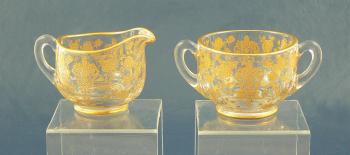 much wider view and as I became
aware of the huge numbers of
options available, my focus
began to narrow and I gravitated
to sugars and creamers without
even realizing it. I was introduced to
glass collecting by my former mother-in-law
and friend, Hazel Jackson. Hazel's mother had a set of green
Hocking Cameo dinnerware which she used as her everyday
dishes and when she passed those dishes onto her daughter,
Hazel decided to rebuild a table service for 8. This was in the
mid-1980s. I had three little kids and Hazel and I would pack
up the snacks and strollers and head out on glass-buying trips to
look for green Cameo.
much wider view and as I became
aware of the huge numbers of
options available, my focus
began to narrow and I gravitated
to sugars and creamers without
even realizing it. I was introduced to
glass collecting by my former mother-in-law
and friend, Hazel Jackson. Hazel's mother had a set of green
Hocking Cameo dinnerware which she used as her everyday
dishes and when she passed those dishes onto her daughter,
Hazel decided to rebuild a table service for 8. This was in the
mid-1980s. I had three little kids and Hazel and I would pack
up the snacks and strollers and head out on glass-buying trips to
look for green Cameo.
Attempting to purchase any Depression Glass in Utah and
the surrounding states is an exercise in long distances driven
for very little reward. Hazel started picking up Depression
and Elegant Glass vases in addition to the Cameo,
just so we would have some fun returns
on our efforts. The kids enjoyed
Grandmas glass hunting trips and
we let them choose little vases
to add to Grandma's collection.
Hazel's vase collection grew
by leaps and bounds, her Cameo
collection grew slowly. I became
 the keeper of an inventory list so we
didn't purchase duplicate vases and that led
me to purchase a used copy of Gene Florence's Collector's
Encyclopedia of Depression Glass, 3rd Edition. It had been
water damaged and it smelled funky. I still have that book and
it still smells funky. Other books followed as did a subscription
to The Daze which we found to be very helpful in locating
scarce Cameo pieces. At some point, I started purchasing a few
pieces for myself, mostly small items. My budget was limited
as was my display space. The sugars and creamers just sort of
quietly moved in.
the keeper of an inventory list so we
didn't purchase duplicate vases and that led
me to purchase a used copy of Gene Florence's Collector's
Encyclopedia of Depression Glass, 3rd Edition. It had been
water damaged and it smelled funky. I still have that book and
it still smells funky. Other books followed as did a subscription
to The Daze which we found to be very helpful in locating
scarce Cameo pieces. At some point, I started purchasing a few
pieces for myself, mostly small items. My budget was limited
as was my display space. The sugars and creamers just sort of
quietly moved in.
I'll stop with the historical narrative right here, I'm sure you can fill in the blanks with pieces from your own story about how you got into glass collecting, or the stories of your friends. Many of our stories are remarkably similar. My collection waxed and waned, my interests changed, my financial situation changed, the size of my house changed and during those years when I was paying for groceries and car insurance for 3 teenage boys, I didn't purchase any glass at all. And through all that, the sugar and creamer sets persevered. They were diverse, required less space to display and they sparkled like many different colored jewels in the modest china cupboard that I had acquired. And the majority of them were unidentified.
About 5 years ago, I seriously
began to identify my sugar and
creamer collection and I found that I
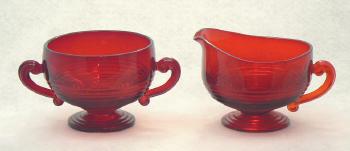 needed a book that was just devoted to sugars
and creamers (S&C). The sheer number of sets that were not
illustrated in the Depression and Elegant Glass books was
astounding. The book I needed didn't exist, so I put together
my own. It was a blue, three-ring binder and it got heavy real
fast. The rest, as they say is history.
needed a book that was just devoted to sugars
and creamers (S&C). The sheer number of sets that were not
illustrated in the Depression and Elegant Glass books was
astounding. The book I needed didn't exist, so I put together
my own. It was a blue, three-ring binder and it got heavy real
fast. The rest, as they say is history.
At 40 pages, the Cambridge chapter is the largest chapter in Book 1. Much of that is owed to the dedicated folks in the Cambridge Collecting Clubs and the NCC who took the time to reprint the catalogs and make the material available for everyone's benefit. Very early in the process of collecting photographs, I had the privilege of being invited into the home of a couple who had hundreds of Cambridge S&C sets. This was the day that I realized there was enough variety and selection within Cambridge S&C that you could spend a lifetime just concentrating on Cambridge.
The other thing that happened to
me that day, standing in that house
seeing all of that beautiful Elegant glass
 displayed together was the realization that the decorations
could not be ignored. That may be a funny thing to read if you
have always been surrounded by decorated Elegant glass, but
bear in mind, I've lived in Utah my whole adult life. Not only
did most Elegant Glass patterns never make it to this part of
the Intermountain West in their original distribution but the
decorated barware which celebrated the end of Prohibition
had little market out here amongst the pragmatic, teetotaling
Mormon farming communities. Decorated S&C were typically
associated with the serving of coffee or tea to guests and the
Mormons didn't partake of coffee or tea. Up until that point,
I was only going to include sugar and creamer blanks for
identification purposes. I was not going to show decorated
pieces because this was a book about the S&C, not the
decorations. That day, I realized that you can't
ignore the decorations and I decided to
include photos of the wonderful
and stunning eye-candy of
the many decorated S&C
sets. So while it's still not a
book about the decorations,
I included as many different
decorations as I could fit into
the limited space that I had.
displayed together was the realization that the decorations
could not be ignored. That may be a funny thing to read if you
have always been surrounded by decorated Elegant glass, but
bear in mind, I've lived in Utah my whole adult life. Not only
did most Elegant Glass patterns never make it to this part of
the Intermountain West in their original distribution but the
decorated barware which celebrated the end of Prohibition
had little market out here amongst the pragmatic, teetotaling
Mormon farming communities. Decorated S&C were typically
associated with the serving of coffee or tea to guests and the
Mormons didn't partake of coffee or tea. Up until that point,
I was only going to include sugar and creamer blanks for
identification purposes. I was not going to show decorated
pieces because this was a book about the S&C, not the
decorations. That day, I realized that you can't
ignore the decorations and I decided to
include photos of the wonderful
and stunning eye-candy of
the many decorated S&C
sets. So while it's still not a
book about the decorations,
I included as many different
decorations as I could fit into
the limited space that I had.
Fast forward to October 2011. The book was
nearly complete and I was working
through the final editing pass
before I gave the file to the book
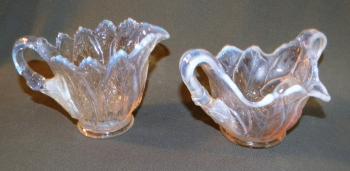 designer, and I came across
a reference for the Miami
Valley Study Group website.
I was curious so I launched
my browser toward www.mvsg.org and clicked on the glass photo
albums. My heart skipped a beat and then it
started beating really fast. There were S&C here that I didn't
have in my Cambridge chapter. Oh my. Lots of them. At that
point, the Cambridge chapter was at 38 pages and I was out of time,
but I had to write and see if the MVSG would allow me to
use some of their images.
designer, and I came across
a reference for the Miami
Valley Study Group website.
I was curious so I launched
my browser toward www.mvsg.org and clicked on the glass photo
albums. My heart skipped a beat and then it
started beating really fast. There were S&C here that I didn't
have in my Cambridge chapter. Oh my. Lots of them. At that
point, the Cambridge chapter was at 38 pages and I was out of time,
but I had to write and see if the MVSG would allow me to
use some of their images.
I didn't wait for a reply; I started working immediately on a chapter rewrite. It killed me to remove some of the photos that I had included. But I was able to incorporate 95% of the catalog reprints which I had asked for while only adding 2 pages. Now ... all I needed was permission to use the images. It seems backward, I know, but I was flying low and fast at this point. We wanted to get the book out in time for the Christmas season and the publication date we were shooting for was the end of November. If MVSG did not give me permission, I still had the previous chapter version to fall back on. When I got the email giving me permission, I was so excited. I wanted to fly right down to Florida and give all of them a big hug. Really? Not in Florida, you say? There goes my beach vacation. I put my metal detector away.
As it turns out, it was fortunate that I had taken the initiative to rewrite the chapter because the MVSG group wanted to see how I would use their images. I was able to pull these pages out of my back pocket and turn that email right around. Dave Rankin and Frank Wollenhaupt were so kind and easy to work with. They both graciously offered me some photos which improved on what I already had and were generous enough to proof-read the whole chapter for me. All the while, they were mindful of the fact that I had a deadline looming over my head. The Cambridge pages are bursting with good stuff and I owe both of these men and the whole Miami Valley Study Group my thanks.
So, while this seems like the
happy ending, and you could
stop reading right now and
know more about the writing of
the Cambridge chapter than you ever
thought you wanted to know, it just gets better.
The first proof of the complete
book came back to me for
review and the book designers
had used the old 38-page
chapter. This is the place
where I learned a hard lesson
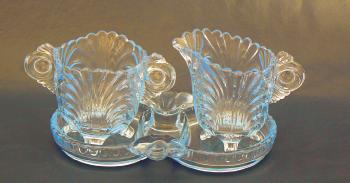 about writing a book. A limit
of 150 pages doesn't mean I get to
write and fill 150 pages. I have to allow for
blank pages at the front and back of the book. The book was
146 pages at this point and I still hadn't completed the 1-page
Bibliography and the 3-page Index. It wasn't that the new 40-page Cambridge chapter couldn't be inserted; it was that there
wasn't any space for it.
about writing a book. A limit
of 150 pages doesn't mean I get to
write and fill 150 pages. I have to allow for
blank pages at the front and back of the book. The book was
146 pages at this point and I still hadn't completed the 1-page
Bibliography and the 3-page Index. It wasn't that the new 40-page Cambridge chapter couldn't be inserted; it was that there
wasn't any space for it.
So the publisher and I put our heads together and tossed
around some ideas. I volunteered to give up the Canton and
Dell chapters. Each was only 1-page in length and it was
that important to keep the Cambridge material intact. But
the Publisher didn't want to lose any of the chapters, so the
decision was made to remove two blank pages, leave all the
existing chapters intact and add the 40-page
Cambridge rewrite. This caused a
several week delay because the
new chapter had to be laid out,
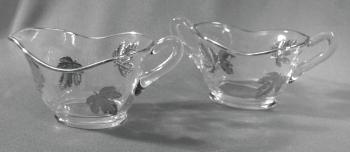 proofed by myself and the
publisher, edits submitted
and incorporated, then
pages had to be renumbered
and only then could page
numbers be inserted into the
index. So while the Cambridge
chapter was responsible for the book
being published 1 month late, it was well
worth it and no one will ever know that I almost took the
guillotine to two little chapters. If removing blank pages seems
simple, open any book and see how the blank pages are used at
the front and the back. They serve to unobtrusively define the
beginning and end of a book.
proofed by myself and the
publisher, edits submitted
and incorporated, then
pages had to be renumbered
and only then could page
numbers be inserted into the
index. So while the Cambridge
chapter was responsible for the book
being published 1 month late, it was well
worth it and no one will ever know that I almost took the
guillotine to two little chapters. If removing blank pages seems
simple, open any book and see how the blank pages are used at
the front and the back. They serve to unobtrusively define the
beginning and end of a book.
My favorite part of the Cambridge chapter was all the colors.
My least favorite part of the Cambridge chapter was all the
colors. I wanted to do the colors justice but I found that in 40
pages, I simply could not. So I hope everyone will forgive
me for not always using the proper Cambridge color
names. Another thing I beg your indulgence
on is the use of a few collector
names. Cambridge collectors have
impressed me as being quite
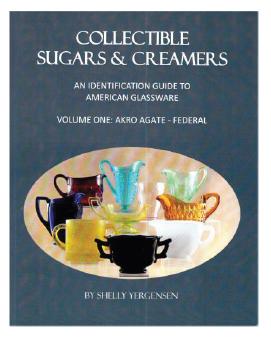 respectful of maintaining the use
of proper historical Cambridge
numbers for identification
instead of using collector names.
S&C collectors are not always as
respectful. When we talk amongst
ourselves, we tend to pick a name that references a particular
visual characteristic so we know which pieces we are referring
to. Many companies used numbering systems and trying to
remember all of those numbers from across 40-50 companies
can result in confusion. It's much easier to remember a unique
name. I shared in the Cambridge chapter some of those
collector names for the Decagon and No. 3400 lines as they are
blanks that vary widely in form but carry the same line name.
I certainly do not imply that anyone should use these names
unless they choose to.
respectful of maintaining the use
of proper historical Cambridge
numbers for identification
instead of using collector names.
S&C collectors are not always as
respectful. When we talk amongst
ourselves, we tend to pick a name that references a particular
visual characteristic so we know which pieces we are referring
to. Many companies used numbering systems and trying to
remember all of those numbers from across 40-50 companies
can result in confusion. It's much easier to remember a unique
name. I shared in the Cambridge chapter some of those
collector names for the Decagon and No. 3400 lines as they are
blanks that vary widely in form but carry the same line name.
I certainly do not imply that anyone should use these names
unless they choose to.
However twisty the path of this journey became, I'm pleased to report that the 40-page Cambridge chapter with all its delightful inclusions is nestled in its rightful place between Beaumont and Canton. Right now it looks like Book 2 will be Fenton – Indiana and I'm working with the goal in mind of having it ready by late Summer 2012.
If you haven't seen the book, I hope you get the opportunity to do so and if you would like to comment about anything, not just the Cambridge chapter, please feel free to write to me at shelly.yergensen@q.com.
